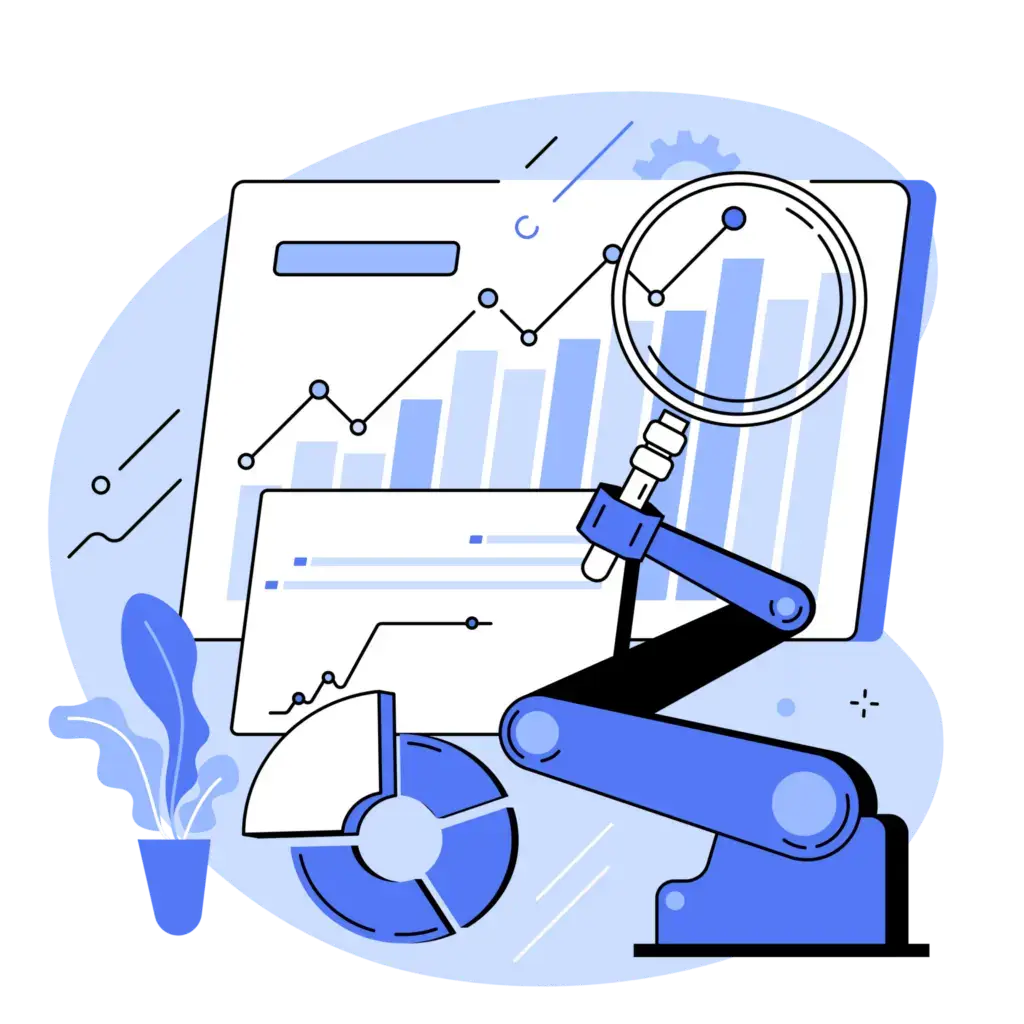Data in its raw form is useless; it’s like a puzzle with missing pieces. To make sense of it all, you must take the first step towards refining it: Data Wrangling.
In this blog post, we will introduce you to data wrangling—what it is, why it’s important in data analysis, and how to use it to turn raw data into actionable insights.
We will cover the basic steps of data wrangling and highlight some of the common challenges that come with it. Additionally, we’ll talk about best practices for efficient data wrangling, tools and technologies available for data wrangling, and advanced techniques such as machine learning-based data wrangling and natural language processing for data cleaning.
Lastly, we will discuss the importance of rotating proxies in data wrangling with a special mention of IPBurger proxies. By the end of this post, you’ll have a comprehensive understanding of how to master the art of data wrangling!
What is Data Wrangling?
Data wrangling, also called “data munging,” is a crucial step in data analysis that involves collecting, cleaning, transforming, and integrating raw data. The importance of data wrangling lies in its ability to ensure the accuracy and completeness of data, allowing for more accurate insights and informed decision-making.
However, despite its significance, data wrangling presents several challenges that can make the process complex and time-consuming. Overcoming these obstacles requires combining technical expertise, critical thinking skills, and best practices.
What is data wrangling vs cleaning?
In short, while data cleaning focuses on ensuring accuracy and consistency in the data set, data wrangling focuses on making the data easier to analyze by reformatting and restructuring it as needed. Both processes are crucial for successful data analysis.
Importance of Data Wrangling in Data Analysis
Accurate and reliable data is essential for data analysis, and that’s where wrangling comes in. By cleaning, transforming, and preparing data for analysis, data wrangling ensures that the insights produced are unbiased and dependable. Without proper data wrangling, the once-accurate results of your analysis may be flawed or inconsistent, leading to erroneous conclusions. Therefore, mastering the art of data wrangling is crucial for streamlining your data analysis process and producing more reliable insights.
What are the Use Cases of Data Wrangling?
Introducing data wrangling in business processes has multiple benefits and use cases. One of its most significant advantages is data cleaning, which removes irrelevant, inaccurate, or incomplete data from datasets. Another critical use case is data integration, where data from various sources can be combined into a cohesive dataset. Data transformation is another option to convert raw data into a more usable format for analysis. Additionally, enrichment can add new information to existing datasets to improve their quality and usefulness. Overall, mastering the art of data wrangling provides businesses with valuable insights that improve decision-making and enhance customer satisfaction.

Market Research
Market research is crucial for any business looking to understand its customers better. Data wrangling can help streamline the market research process by cleaning and organizing large amounts of data. This makes identifying patterns and generating valuable insights that inform product development, marketing strategies, and customer engagement easier. By leveraging the power of wrangling techniques, businesses can make more informed decisions about their target audience and create a more personalized customer experience, ultimately leading to increased revenue and brand loyalty.

Automating Business Processes
Automating business processes is a crucial aspect of data wrangling, as it can save time and improve the accuracy of insights gained from analysis. By automating manual tasks such as data entry and cleaning, businesses can streamline their workflows and focus on analyzing valuable insights. Furthermore, automated data wrangling can help identify patterns and trends in large datasets that may have gone unnoticed. Automating business processes with data wrangling is a smart investment for any organization looking to gain a competitive edge.

Improved Decision Making
With the help of wrangling techniques, organizations can make more informed decisions by using clean and structured data. By transforming and cleansing data, decision-makers can better understand their business operations and identify areas for improvement. Data wrangling also enables organizations to identify patterns and trends in their data analytics, which can inform strategic planning and forecasting. In addition, it helps reduce errors and inconsistencies in data, resulting in more accurate analyses and insights. Overall, improved decision-making is a significant advantage of implementing adequate data-wrangling practices.

Predictive Analysis
Predictive analysis is a powerful tool for making informed business decisions. Data wrangling plays an essential role in this process by cleaning and transforming raw information into a format that can be analyzed. Businesses can predict future outcomes and make data-driven decisions supported by concrete evidence with the aid of predictive analysis. By identifying patterns and trends, organizations can gain valuable insights that enable them to stay ahead of the competition. Ultimately, predictive analysis is one of the most significant benefits of data wrangling, and it is something every organization should consider implementing.

Risk Management
Data mining can be a powerful tool for managing risks for organizations. Companies can identify potential threats and take preventive measures by organizing and cleaning their data. In addition, merging different datasets through data wrangling tools can provide a more comprehensive view of the risks at hand. With proper analysis and visualization of the data, companies can make informed decisions about risk management strategies to mitigate any potential harm. Incorporating data wrangling into risk management processes can help companies avoid potential threats and improve overall business performance.

Enhancing Customer Experience
Businesses can gain a competitive edge by enhancing the customer experience, and wrangling plays a critical role in achieving this goal. By cleaning and organizing customer data, businesses can create targeted marketing campaigns that resonate with their audience. Data wrangling also helps identify patterns in customer purchase history, allowing businesses to tailor product offerings and improve the overall customer experience. In addition, data wrangling aids in detecting fraudulent activity or anomalies, helping businesses ensure the safety and security of their customers’ data. Ultimately, effective data wrangling enables businesses to gain valuable insights into their customers, which can drive growth and profitability.
Basic Steps of Data Wrangling
Data wrangling involves a series of fundamental steps that help transform raw information into insightful information.
- The first step is the data mining process, which involves collecting data from various sources, including APIs and databases.
- Next comes data cleansing, where duplicates are removed, errors are corrected, and missing values are addressed.
- Afterward comes the data transformation phase, which converts the data into a format suitable for analysis by normalizing or aggregating it.
- Finally, external data sources are added to enhance existing datasets in the data enrichment phase. Data validation is performed to ensure the accuracy and consistency of the cleaned and processed data before moving forward with analysis.
Data Collection and Extraction
Before data analysis begins, collecting and extracting raw data from various sources is essential. This munging process can be automated using web scrapers or done manually through surveys or interviews. However, collecting data isn’t enough; it must be relevant to the analysis. Ensuring the collected data is free of errors, duplicates, and irrelevant information is crucial before moving on to the next stage. Once collected, data structuring and data processing become priorities.
Data Cleaning and Filtering
Efficient data analysis relies heavily on clean and accurate data sets. Data cleaning involves identifying and removing errors or inaccuracies while filtering is selecting specific subsets of data based on defined criteria. These steps are critical in preparing data for analysis. Techniques such as imputation, normalization, and deduplication can clean data, while SQL queries or programming languages like Python can filter data. Ensuring your data is free from errors and irrelevant information will yield more accurate and valuable insights.
Data Transformation and Aggregation
When raw data is extracted, it may not be in a suitable format for analysis. Data transformation and aggregation are essential steps in the data wrangling process to convert data into a structured and understandable format. Data transformation includes cleaning, filtering, and reformatting data, while aggregation involves combining multiple datasets or summarizing data to generate new insights. Both of these techniques can provide valuable insights to help businesses make informed decisions and achieve their goals.
Data Enrichment and Augmentation
Adding or enhancing data with external information is called data enrichment; creating new data by merging, combining, or transforming existing data is called augmentation. Both processes are essential for improving the quality and completeness of your dataset. With enriched and augmented data, you can improve the accuracy of your analysis and decision-making. APIs, web scraping, and machine learning algorithms are among the tools and methods used to assist with data enrichment and augmentation.
Common Challenges in Data Wrangling
Data wrangling is a complex process that requires careful attention to detail and skillful execution. Common challenges in data wrangling include dealing with missing or inaccurate data, addressing inconsistencies in data formats and structures, managing large volumes of data, and evaluating the trade-offs between automating data wrangling tasks and using manual methods.
Handling Missing or Inaccurate Data
Missing or inaccurate data is a common challenge in data wrangling that can significantly impact the accuracy of the final analysis. One approach to handling missing data is to delete incomplete records, which can lead to losing valuable information. Another approach is to impute missing values by estimating them based on other available data. On the other hand, it is possible to deal with inaccurate data by locating and fixing errors or eliminating outliers that might skew the results. Ultimately, evaluating the impact of any decisions made regarding missing or inaccurate data on the final analysis is crucial.
Dealing with Inconsistent Formats and Structures
Data wrangling often involves dealing with inconsistent formats and structures, which can be a significant roadblock. It’s not uncommon for data to come in different file types or have varying column names and formats, making it challenging to manipulate the data effectively. However, tools like Python’s Pandas library offer functions that standardize data formats, while manual cleaning and transformation may also be necessary to ensure consistency. Addressing inconsistencies with patience and thoroughness is key to successful data wrangling.
Managing Large Volumes of Data
Handling large volumes of data is a daunting task but crucial in the world of data wrangling. One must clearly understand the data’s source and structure to manage it efficiently. You can accomplish this by using tools like distributed computing or cloud storage, making managing the datasets simple. Data compression techniques can also come in handy for reducing the size of data without losing important information. Proper organization and documentation of data further simplify the process, ensuring that you won’t lose track of critical details while managing large volumes of data.
Best Practices for Efficient Data Wrangling
Efficient data wrangling is critical to ensuring accurate and reliable insights from your data. To achieve this, starting with a better understanding of the data and its sources is essential. Tools like spreadsheets, scripting languages, or specialized software can speed up data cleaning and transformation. Documentation at every step of the way ensures reproducibility and makes it possible for team members to collaborate more effectively. Checking for inconsistencies, missing values, outliers, and errors in the data is also crucial. Finally, exploring and visualizing the data are important steps that help refine the analysis and gain insights quickly.
Automating Data Wrangling Processes
Data wrangling can be time-consuming and repetitive, which is why automating data wrangling processes can be a game-changer. Automation tools like Python, R, and SQL can help to streamline tasks such as data cleaning and transformation. APIs can also make it easier to extract data from various sources. However, testing and validating automated processes is essential to ensure accuracy and reliability. Regular maintenance and updates may also be required to keep automated processes running smoothly. Automating data wrangling processes can save time, reduce the risk of human errors, and improve overall efficiency.
Using Version Control for Data Workflows
Maintaining a record of changes made to data is crucial to ensure reproducibility and collaboration while data wrangling. Version control tools like Git can help manage changes, track progress, and identify data inconsistencies. By using Git, team members can work on the same project simultaneously, revert to previous versions if needed, and maintain a clear record of all changes made. Using descriptive file names and documenting the changes made to data files can also improve collaboration and efficiency during the data wrangling process.
Collaborating with Team Members on Data Projects
Effective collaboration is crucial in data wrangling projects. Team members should establish clear communication channels and define specific roles and responsibilities to streamline the process. A shared platform or tool can be utilised to ensure everyone has access to the same data. Regular progress updates can help identify potential issues early on, while data security and privacy protocols must be established to protect the project’s integrity. Team members can overcome common challenges and achieve successful outcomes by working together.
Tools and Technologies for Data Wrangling
Data wrangling requires a range of tools and technologies to process data efficiently. Data cleaning tools like OpenRefine and Trifacta are ideal for tidying up messy data, while Python, R, and Apache Spark can be used for data transformation.
For integrating data from multiple sources, ETL (Extract, Transform, Load) tools like Talend or Informatica are incredibly useful.
Cloud-based platforms like AWS or Google Cloud Platform offer scalable and cost-effective data management and analysis solutions. Data visualization tools like Tableau or Power BI can also help create interactive visualizations for better insights.
OpenRefine
OpenRefine is a powerful open-source tool for cleaning and transforming data. It offers a range of features such as sorting and filtering data, exploring large datasets, and reconciling data with external sources. OpenRefine allows users to split or combine columns, remove duplicates, and apply regular expressions to clean data. It supports different types of data formats, including CSV, Excel, JSON, XML, and RDF. The active community behind OpenRefine continually develops new plugins that extend its functionality and provide support to users. With its user-friendly interface and extensive features, OpenRefine is an ideal tool for any data wrangling project.
Trifacta
Trifacta is a versatile data wrangling tool that simplifies cleaning and transforming data. It uses machine learning algorithms to identify patterns in large datasets, which can be used to suggest transformations automatically. Trifacta’s user-friendly interface makes creating complex rules and transformations easy, even without extensive programming knowledge. Additionally, Trifacta allows collaboration among team members, which helps streamline data wrangling workflows. Its robust features and ease of use make it a popular choice among data professionals.
Paxata
Paxata is a self-service data preparation platform that offers an easy-to-use visual interface for data wrangling tasks. With its machine learning algorithms, Paxata simplifies repetitive tasks and suggests transformations to prepare data from multiple sources. The platform also supports collaboration among team members, providing detailed audit trails for compliance and governance purposes. Paxata’s integration with popular analytics tools like Tableau and Excel allows users to export cleaned data effortlessly. Its user-friendly interface and powerful features have made it popular among non-technical users in recent years.
Advanced Techniques in Data Wrangling
Data wrangling involves several advanced techniques that help refine raw data into insights. These include complex data cleaning, transformation, manipulation, enrichment, and automation. Data cleaning is the process of removing irrelevant or inconsistent data to improve its quality. Data transformation involves converting data types and formats to standardize them. Data manipulation combines multiple datasets to extract useful insights. Data enrichment adds external sources to enhance analysis. Finally, automation can streamline the entire process and reduce errors. Mastering these techniques helps analysts uncover hidden patterns and make informed decisions from vast amounts of data.

Machine Learning-based Data Wrangling
Machine learning-based data wrangling involves machine learning models to automate cleaning and transforming data. By training the modeling to recognize patterns in large data, analysts use less time and reduce errors compared to manual data wrangling. However, this approach requires significant data preparation and may not be suitable for all data types. It is crucial to consider whether machine learning-based data wrangling is appropriate for the specific project.

Natural Language Processing for Data Cleaning
Cleaning text data can be daunting, but Natural Language Processing (NLP) techniques can help streamline the process. Using NLP libraries like TextBlob and NLTK, messy text data can be tokenized, stemmed, and lemmatized to standardize the text format. Regular expressions are also useful in identifying patterns for cleaning. The use of NLP for data cleaning can save time and enhance analysis accuracy.
Importance of Rotating Proxies in Data Wrangling
Scraping data from websites can be a challenge when it comes to data wrangling. This is where rotating proxies come in handy. By constantly switching the IP address used for web scraping, rotating proxies help prevent IP blocking and improve the success rate of data collection. Additionally, rotating proxies allow you to access geo-restricted data that may not be available in your location. Implementing rotating proxies can save time and resources while ensuring successful and efficient data wrangling.
IPBurger Proxies
Ensuring anonymity and avoiding detection is essential when collecting data for your projects. IPBurger Proxies offers a reliable and secure solution with their rotating proxy service.
These proxies are fast, anonymous, and come with a user-friendly dashboard, making the management of data wrangling more efficient. Additionally, rotating proxies can improve data accuracy by preventing duplicate entries or incomplete datasets.
Incorporating rotating proxies into your process can save time, increase efficiency, and ensure data accuracy.
Conclusion
Data wrangling is a crucial step in the data analysis process. It helps you transform raw, unstructured data into organized, refined data that can be used for various purposes like market research, predictive analysis, and improved decision-making. However, it comes with challenges like handling missing or inaccurate data and managing large volumes of data.
To overcome these challenges and efficiently master the art of data wrangling, you need to follow certain best practices like automating data wrangling processes and collaborating with team members on data projects. To simplify the process, you can also use tools and technologies like OpenRefine, Trifacta, and Paxata. To learn more about advanced techniques in data wrangling and how rotating proxies like IPBurger Proxies can help you achieve your goals, explore our comprehensive guide on mastering the art of data wrangling from raw to refined.



